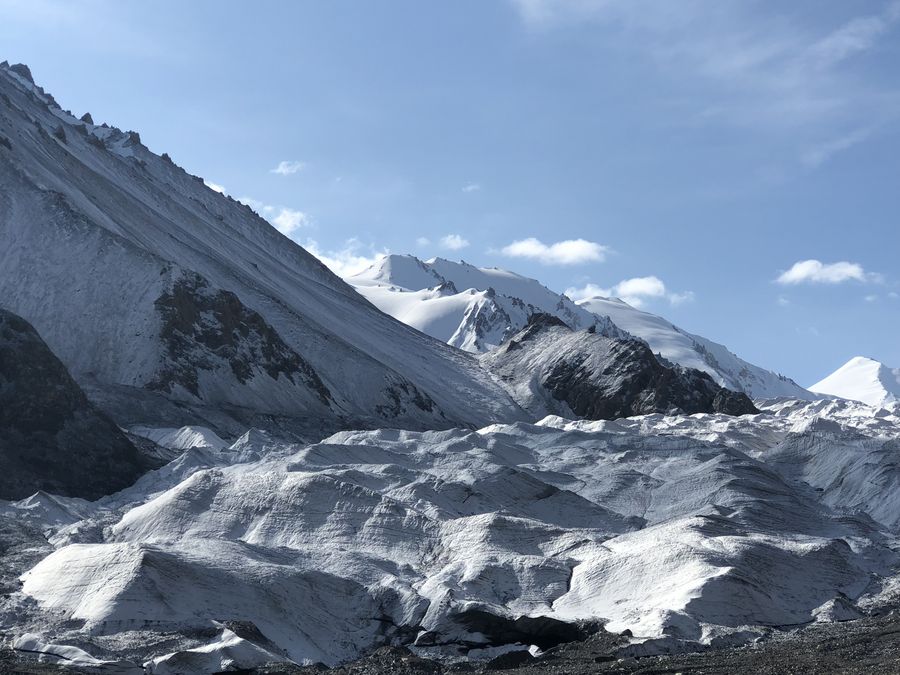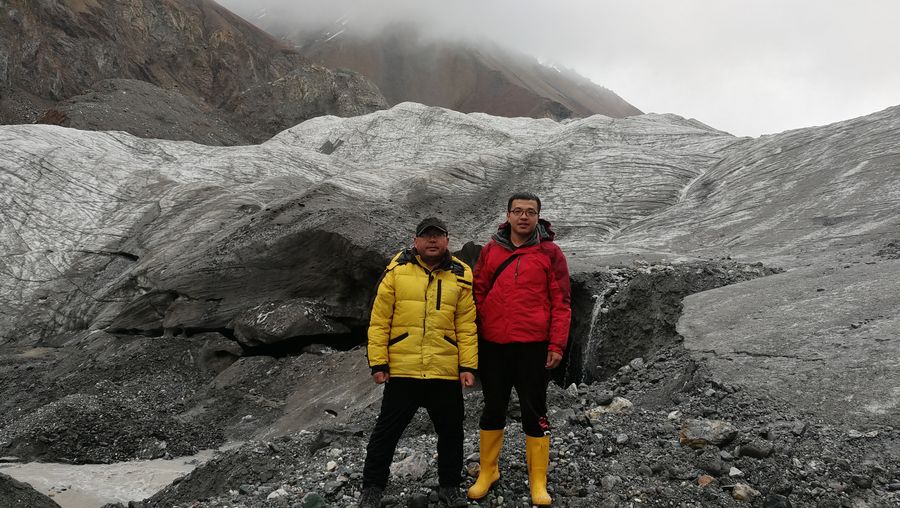
Laohugou Glacier No.12 is the largest valley glacier in the Qilian Mountains. (Xinhua/Zhang Wenjing)
Qin Xiang, 46, has devoted himself to the research and protection of glaciers in the Qilian Mountains for more than 20 years.
Qin's team has collected a large amount of research data regarding changes of glaciers and the influence of human activities on glaciers.
LANZHOU, Sept. 5 (Xinhua) -- Spending almost half of his life studying glaciers in the Qilian Mountains in northwestern China, Qin Xiang has gotten used to countless crevasses, and fierce winds and snow in areas at an altitude of over 4,000 meters above sea level.
Qin is a researcher with the Northwest Institute of Eco-Environment and Resources of the Chinese Academy of Science (CAS). The Ph.D. supervisor has devoted himself to the research and protection of glaciers in the Qilian Mountains for more than 20 years.
The rugged mountain range, located on the border of northwestern China's Qinghai and Gansu provinces, is one of the country's main mountain ranges.

Qin Xiang (left) poses with his student Jin Zizhen at Laohugou Glacier No.12 on Aug. 7, 2019. (Xinhua/Du bin)
Qin was very interested in geography when he was little, and dreamed of becoming a scientist. Qin said he learned the story of Qin Dahe, the first Chinese to cross Antarctica on foot and a well-known glaciologist when he was studying at university. It was then that the seeds of passion for glaciers took root in his heart.
Qin managed to get closer to his idol and his glacier dream when he became the postgraduate student of Qin Dahe, a researcher with the CAS, in 1995.
"My hobby finally turned into my career," he said, who started to research glaciers in the Qilian Mountains nine years later.
There are more than 2,000 glaciers scattered on the top of the mountains, which are important sources of major rivers and lakes. Qin concentrates on the research of the largest valley glacier Laohugou Glacier No. 12.
Observation and research on Laohugou Glacier No. 12 were launched in the early 1950s, soon after the founding of the People's Republic of China in 1949. More scientific research has been conducted since global warming has sped up the melting of glaciers, which raised the concerns of an increasing number of scientists.
To enhance the monitoring and research of glaciers in the Qilian Mountains, the CAS established an ecological research station on Laohugou Glacier No. 12 in 2005, with Qin being head of the station.
With a dozen makeshift rooms, the station sits at an altitude of 4,200 meters above sea level, far away from habitable areas. The location has weak cell phone signal and Internet connection, and the researchers have long suffered cold, hypoxia, supply shortages and harsh weather.
It is easy to get lost when blizzards sweep the mountains and suffer from sunburns after exposure to strong ultraviolet rays, Qin said.

Qin Xiang (right) shows his student Jin Zizhen how to make hydrological observations on Aug. 7, 2019. (Xinhua/Du Bin)
Qin's work is to get core samples from high mountain glaciers.
"Glaciers are super sensitive to temperature fluctuations accompanying climate change, ice cores from the glaciers can help find the cause of climate change. But it is by no means an easy task," Qin said.
Drilling ice core in the glaciers is an arduous challenge for Qin, who still remembers his first drill in 2005.
He led four team members to get the ice cores in October 2005. They stumped more than 9 km up the mountains to reach the destination more than 5,000 meters above sea level at around 4 p.m. However, they could not obtain satisfactory ice cores until 2 a.m. the next morning. They had to return to the research station, along with heavy equipment.
Walking on the rugged and slippery mountain, they only had flashlights to illuminate the way back to the station. They eventually reached the station at 9 a.m.
"Although we failed, we gained experience," said Qin, whose team has obtained a large number of ice cores from different altitudes in the mountains. They even successfully drilled an ice core to the bedrock from a glacier in Qilian Mountains.
"If you experience challenges when you're young, dealing with hardships in the future will be easier," said Qin.
Over the past decade, Qin's team has collected a large amount of research data regarding changes of glaciers and the influence of human activities on glaciers.
The latest data showed that Laohugou Glacier No. 12 has shrunk significantly. From 1960 to 2018, the glacier has lost an estimated 0.33 cubic km of ice and receded 403 meters, and the thickness of the glacier has decreased by 12.7 meters on average.
"Learning from the past can help you better predict the future," said Qin, who believes that the research and protection of glaciers should be carried on by future generations.
"We must persevere no matter how hard it is," the 46-year-old said.
Qin said the team would continue to focus on the Qilian Mountains and the surrounding areas, carry out long-term monitoring of the changes, impacts of the cryosphere and establish a sharing research platform, providing scientific and technological support for environmental protection and sustainable development.



